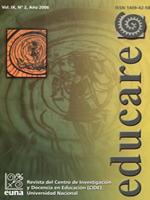Estrategias y toma de decisiones para la Educación a Distancia
DOI:
https://doi.org/10.15359/ree.9-2.5Abstract
An excellent process for distance education consists of many stages of design, development, evaluation, and revision. The design has to take into account, not only, themes, needs, students’ characteristics, instruction; but also, technological commitment.
This article explains some strategies and possible technological resources that can be used in the distance educational process. This article recommends to the Universities and Educational Institutions to give priority to these concepts in order to offer high-quality education.
References
Amundsen, Cheryl. (1993). "The evolution of theory in distance education". En Desmond Keegan (Ed.). Theoretical principies of distance education. Great Britain: Routledge, 1993, 61-79. Traducción: Jorge Méndez.
Barrón, Héctor S. (1996). La educación en línea y el texto didáctico. Universidad Nacional Autónoma de México (UNAM). México, D.F.
Bates, A.W. (2001). Cómo gestionar el cambio tecnológico. Estrategias para los responsables de centros universitarios. Barcelona: Ediuoc-Gedisa.
Garrison, D.R. (1995). "Three generations of technological innovations in distance education". Distance Education 6(2), 235-41.
Keegan, D.J. (1986). The foundations of Distance Education. London: Croom Helm ( 1990). Foundations of Distance Education (2. edn.) London: Routledge.
Méndez, Jorge. (2004). Videoconferencia grupal. Estructura de la comunicación y diseño instruccional. Documento electrónico. CUAED-UNAM.
Pisanty, Alejandra. (2000). "Dos taxonomías de los medios técnicos para la educación a distancia". En: Revista Digital Universitaria, volumen 1, Nº O. Dirección General de Servicios de Cómputo Académico-UNAM-Ciudad Universitaria, México, D.F.
Roquet García, Guillermo. ( 1998). Los foros de discusión en educación. Siglo XXI: Perspectiva de la educación a distancia desde América, año 4, N
º 10, 69-78.
Roquet García, Guillermo. (2004). Los chats y su uso en educación. Documento electrónico. CUAED-UNAM.
Downloads
Published
How to Cite
Issue
Section
License
1. In case the submitted paper is accepted for publication, the author(s) FREELY, COSTLESS, EXCLUSIVELY AND FOR AN INDEFINITE TERM transfer copyrights and patrimonial rights to Universidad Nacional (UNA, Costa Rica). For more details check the Originality Statement and Copyright Transfer Agreement
2. REUTILIZATION RIGHTS: UNA authorizes authors to use, for any purpose (among them selfarchiving or autoarchiving) and to publish in the Internet in any electronic site, the paper´'s final version, both approved and published (post print), as long as it is done with a non commercial purpose, does not generate derivates without previous consentment and recognizes both publisher's name and authorship.
3. The submission and possible publication of the paper in the Educare Electronic Journal is ruled by the Journal’s editorial policies, the institutional rules of Universidad Nacional and the laws of the Republic of Costa Rica. Additionally, any possible difference of opinion or future dispute shall be settled in accordance with the mechanisms of Alternative Dispute Resolution and the Costa Rican Jurisdiction.
4. In all cases, it is understood that the opinions issued are those of the authors and do not necessarily reflect the position and opinion of Educare, CIDE or Universidad Nacional, Costa Rica. It is also understood that, in the exercise of academic freedom, the authors have carried out a rogorous scientific-academic process of research, reflection and argumentation thar lays within the thematic scope of interest of the Journal.
5. The papers published by Educare Electronic Journal use a Creative Commons License:















 The articles published by Educare Electronic Journal can be shared with a Creative Commons License:
The articles published by Educare Electronic Journal can be shared with a Creative Commons License: 



